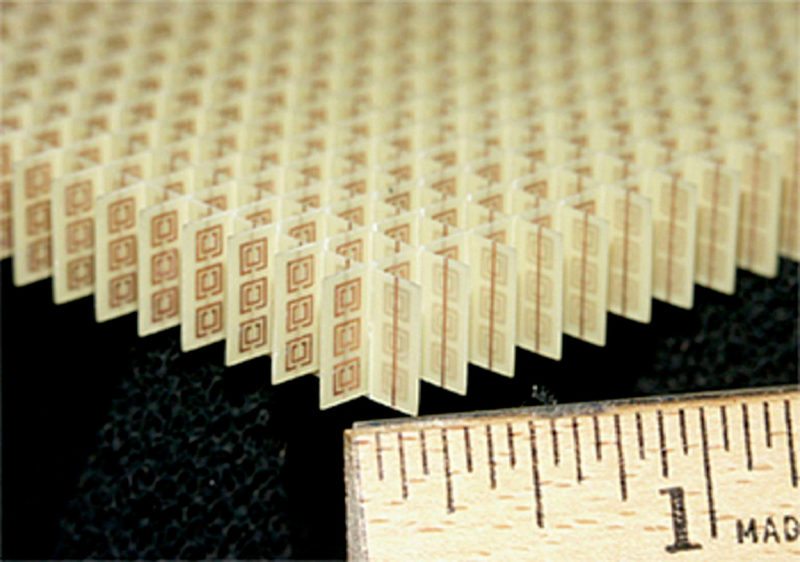Though development and use of invisibility cloaks may not have been possible till now for large-scale objects, the technology towards invisibility based on the exotic properties exhibited by meta-materials is now well understood by scientists, engineers and technologists. So we are no longer unaware of the use of invisibility in electronics.
As components on computer chips get smaller, we have to come up with strategies to control electron transport, and use of invisibility characteristics of materials in electronics might be one useful approach. The concept could also lead to a new kind of switches for electronic devices. The switch could operate by toggling between transparent and opaque states of electrons, thus turning a flow of these on and off. This article briefly summarises the developments towards the applications of the concept of cloaking to the domain of electrons that is giving rise to more useful, efficient, smart and lightweight electronic devices. The new invisibility cloak combines meta-materials and leads fancy electronics to be thinner, lighter and invisible.

Invisibility fundamentals
The last few years have seen a lot of research in invisibility cloaks. These cloaks are mostly based on meta-materials—special, man-made materials that bend radiation in ways that should not technically be possible—allowing for cloaking devices that bend radiation around an object, hiding it from view.
The problem with these cloaks is that meta-materials are tuned to a very specific frequency. So while that specific frequency passes around the object, every other frequency scatters off the cloaks.
In a beautiful twist of irony, most invisibility cloaks actually create more scattered light, making the cloaked object stand out more than if it was just standing there uncloaked. This is a fundamental issue of passive invisibility cloaks, and the only way to get around it is to use cloaks fashioned out of active, electrically-active materials.
This might change in the future with more advanced passive meta-materials, but for now, active designs are the way forward. Research into active invisibility cloaks is currently being carried out by multiple research groups all over the world, but none have yet been built.
Invisibility cloaks are supposed to hide things by bending light around these that would not allow any to be reflected back at a potential viewer, which would allow the invisible thing to be seen.
Invisibility cloaks, which are very successful in movies and are so close to being successful in labs, have a crucial weakness. These make things invisible to the perception of the audience their creators had in mind.
Previous work on cloaking objects from view has relied on so-called meta-materials made of artificial materials with unusual properties. The composite structures used for cloaking cause light beams to bend around an object and then meet on the other side, resuming their original path, making the object appear invisible.
The great unappreciated weakness of invisibility cloaks is that these only make things invisible to human eyes. A cloak made to hide things from humans would be able to bend all colours of visible light, but might not be able to do the same with waves of heat or sound.
It has never been clear whether it was even theoretically possible to make an invisibility cloak that could hide the same object from light, heat and sound. The problem is not just that the cloak material has to bend light, but that it has to have an effect on the light, powerful enough to change its behaviour in very specific ways.
A mirror can change the behaviour direction of a beam of light dramatically, and can hide a person standing behind it, for example, but does not do those things with enough subtlety to convince anyone that it is not there. An advanced meta-material from the category of meta-materials often used in attempts at invisibility might have a powerful, innate ability to scatter light, but could melt when exposed to a lot of heat, or catch fire when in contact with electricity.
Researchers have addressed the need for a material that could manipulate more than one type of material by making a cloak out of two different layers of material with different properties, but each has to be able to shield the other from view within its own slice of the energy spectrum.
A team of researchers has built a double layer of material as a cloak that can keep objects from being seen using either heat or electricity as a viewing medium, using a layer of silicon that attracts and concentrates both electrical current and heat flow, and an inner layer that is actually an empty cavity that scatters both current and heat away from itself. So when an object is placed within the invisibility zone, heat and electricity are diverted around it and scattered around the inside of the cavity. The outer shell then pulls both heat and electricity towards itself, removing the means of being seen from the neighbourhood of the object being hidden.Holes are drilled in the outer layer and filled with a material called polydimethylsiloxane, which conducts heat and electricity little or not at all compared to silicon. The combination of two materials scatters heat and electricity randomly enough to make the accumulated energy difficult to notice.
Invisibility to electronics
The combined effect of invisibility on heat and electricity could be used to help eliminate unwanted electrical and heat energy from sensitive electronic components, which could eliminate much of the source of static that make radio reception less clear or sap the performance of the devices themselves. The technique, which boils down to protecting an object from heat and electricity by scattering it away, might also be useful in overcoming the performance barriers that have made it difficult to increase the efficiency of thermo-photovoltaic cells in solar power systems.
A dual-purpose cloak that scatters electricity and magnetism could also make low-frequency signals clearer. A powered device that accomplishes the same thing could make the technique useful at a more macro level as well. The goal is to find an efficient way to solve the fundamental problems on the undesired electrical-thermal entanglement, for example, turning dissipated heat into a useful source of energy.
This is very exciting work that expands the concept of cloaking to the domain of electrons and, thus, uncovers an interesting approach that may be very useful to thermoelectric applications. Researchers are applying technology developed for the visual cloaking of objects to enable particles hide from passing electronics, which could lead to more efficient thermoelectric devices and new kinds of electronics, thus, making invisibility a key for better electronics.
The new concept could improve the flow of electrons by orders of magnitude and eventually lead to more efficient filters, sensors and thermoelectric devices, and new kinds of electronics. As the components on semiconductors get smaller, the new concept could be used as a better strategy for electron transport. The concept could also lead to a new kind of switches for electronic devices.

Technological advances
Normally, electrons travel through a material in a way that is similar to the motion of electromagnetic waves. In the new electron-cloaking material that has been developed, the process is slightly different. Researchers wanted to carry on further research on how to make some real devices out of this strategy. They developed the idea of harnessing the cloaking mechanisms developed to shield objects from view, applying it to the movement of electrons.
Researchers are now applying the technology developed for visual cloaking of objects to enable particles to hide from passing electronics. The probability flux of electrons is a representation of the paths of electrons as these pass through an invisible nanoparticle. While the paths are bent as these enter the particle, these are subsequently bent back so that these re-emerge from the other side on the same trajectory these started with—just as if the particle was not there.
The electronic switch could operate by toggling between transparent and opaque states of electrons, thus, turning a flow of these on and off. The concept appears to work in computer simulations, according to the researchers, as they move on to building actual devices to see whether these devices perform as expected.
The initial concept was developed using particles embedded in a normal semiconductor substrate. Now, researchers would like to see if the results can be replicated with other materials, such as 2D sheets of graphene, which might offer interesting additional properties.
They modelled nano-particles with a core of one material and a shell of another. But in this case, rather than bending around the object, electrons actually pass through the particles. Their paths are bent first one way, then back again, so these return to the same trajectory these began with.
The researchers’ initial impetus was to optimise the materials used in thermoelectric devices, which produce an electrical current from a temperature gradient. Such devices require a combination of characteristics that are hard to obtain—high electrical conductivity (so that generated current can flow freely), but low thermal conductivity (to maintain a temperature gradient). But the two types of conductivity need to coexist, so only a few materials offer these contradictory characteristics.
Simulations show this electron-cloaking material could meet these requirements unusually well. The simulations uses particles a few nanometres in size, matching the wavelength of flowing electrons and improving the flow of electrons at particular energy levels by orders of magnitude compared to traditional doping strategies. This might lead to more efficient filters or sensors.
Latest development status
A researcher at University of Texas at Austin, USA, has devised an invisibility cloak that could work over a broad range of frequencies, including visible light and microwaves. This is a significant upgrade from current invisibility cloaks that only cloak a very specific frequency, say, a few hertz in the microwave band, and, more importantly, actually make cloaked objects more visible to other frequencies. This cloak could achieve the goal by being active and electrically-powered, rather than dumb and passive like existing invisibility cloaks.
Another proposed design consists of a conventional meta-material base, but with CMOS negative impedance converters (NICs) placed at the corner of each meta-material square. An NIC is an interesting electronic component that adds negative resistance to a circuit, injecting energy rather than consuming it. NICs are not widely used as researchers are not entirely sure how to use these. This seems to propose that, by interspersing NICs (which must be powered) with the meta-material, multiple frequencies can be cloaked. The proposed cloak is invisible over a large range of frequencies, while a standard passive cloak is only invisible for a small range, and more visible than non-cloaked devices in other ranges.










